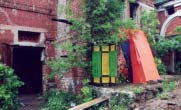
Gillian McIver
What is the future of art as site-response? Is it a temporary reaction to specific
social, political and economic situations and discourses? Or is it a new direction
or movement in art, marked by close interaction with specific realities and
hybrid media? It is far too early in the history of this fragile and tentative
movement in contemporary art, to make any conclusions. But as artists reach
out into their communities and the wider world, seeking engagement and challenges,
the continuing relationship between art, artist and locality raises questions
that, even if they cannot be answered, provoke and renew the debate.

Is the “impermanence and transience” of the site-responsive art object/event described by Miwon Kwon a form of resistance to the commodification of the art and the artist?[1] The author goes on to say that Where site-specific art once defied commodification by insisting on immobility, it now seems to espouse fluid mobility and nomadism for the same purpose. Curiously however, the nomadic principle also defines capital and power in our times. Is the unhinging of site-specificity then, a form of resistance … or a capitulation to the logic of capitalist expansion?[2]
 |
 |
 |
 |
Put this way, “the nomadic principle” implies an either/or situation – either resistance or capitulation. I would argue that bothforms are possible and which is employed can only be judged by analysis of the individual art works. It is true that the great changes of the modern world since 1989 for example, have caused artists as well as everyone else to react to the ease of movement of people and cultural products around the globe. Whether this is a new freedom, or simply a reaction to change, is impossible to determine.
But issues of locality and identity persist.[3] Vazo’s interventions
in the abandoned industrial areas of Gyumri (his home town) emphasise his detournément
of the empty hulks into art objects, and at the same time highlight the great
social and political change that has come to his country: under Soviet rule
such action would have been utterly forbidden. As well as highlighting the economic
and topographical change, Vazo is also asserting his freedom – and also
its price (during Soviet times, Gyumri would have been rebuilt; the new Republic
of Armenia cannot afford to do so.) So a very local concern –
ruined urban space – takes on a multiplicity of meanings that reach outward
into the global arena. Vazo’s Gyumri project has been exhibited in Moscow
and is online where it can reach innumerable audiences. This is one example
of the “particular to the universal” that site-responsive work is
empowered to do.
In addition, I would also argue that artists choose to work site-responsively for their own reasons, and one of those reasons must be that they actually like “the nomadic principle” in their lives and work.

Again however, I would argue that the peculiar subtle difference of site-response as opposed to site-specific, which involves an insistence on the actual dialectic between artist and all aspects of the space, not only the physical, means that there may be less chance for any “characteristic mode of operation” to occur at all. There is great potential for site-responsive art to develop this dialectic to constantly create fresh interventions into “everyday life” while at the same time universalising through art the concerns that are, at their base, bound in human time and space.
The opening of the site to art is a brief, interventionist moment, not a permanent condition. Even media art is subjected to this condition, when it is site-based. Even a video projected on the wall of a building integrates with the structure: when it is moved to another space it is a different work.
So a consciousness not only of time but of change or flux is at the very foundation of this type of work. Different experiences of time and change intersect: historical time (the lived experience of the site); material time (the materials used); experiential time (the actual period of the intervention).

This deep role of time and change as the basic subject matter is part of the condition of “post-industrial art.” This art that emerged on the cusp of the Millennium, from the late 1980s to the present. Art made in the wastelands of urban dereliction, in the consciousness of the postindustrial state we live in, where old structures that bound social existence, such as factories, hospitals, lidos and schools have been abandoned to new ideologies. As artists we are compelled by the notion of the “reintegration of fragments” or what Anselm Kiefer has described as “bringing together what has come apart.” This interest in site-response is part of a larger picture, in which art grapples with existential notions of fragmentation and time.
Moving across the world from site to site, like archaeologists, uncovering memories, stories, small objects. Cleaning rubbish out of a building. Putting up a paper “window” where no glass has been for fifty years. Making sound in an empty machine hall. Projecting an image onto a blank crumbling wall. Bringing human life back into a sarcophagus-like void. Putting things back together.
Notes
1 Commodification of the artist in the UK is dealt with by Julian Stallabrass
in High Art Lite – for other examples just pick up any popularmagazine
or supplement.
2 Kwon, 31.
3 Recent research into other areas have shown the same conclusions I have found
in my own observation: that people strongly identify with alocality, quite apart
from institutional initiatives. (e.g.Vivienne Pollock of the Belfast Museum
“Yours, Mine or Ours: Translating the Personalfrom the Public” and
Linda Connell’s research into Millennium projects in urban and rural areas
of Britain.) Working site-responsively, artistsautomatically tap into this and
become part of the narrative of the locality, rather than simply placing work.
4 Kwon, 47.

Creative
Commons Attribution-NonCommercial-NoDerivs 2.5 License. GMcIver2004